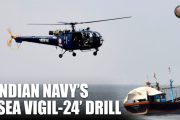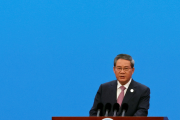Editor’s Note
The article propagates a departure from our reactive posturing along the land borders with China to signal a significant threat to the sea lanes of communications across the Indian Ocean through which its lifelines of crude oil requirements pass. The two port calls that a submarine each of the Indian Navy recently undertook perhaps signals that the feasibility of such an option is being exercised for Chinese strategists to ponder.
…………………………………………………………………………………………………………………

INS Sindhukesari docked in Jakarta, Indonesia, for the first time on February 22 to 24 (Image: Indian Navy)
Many strategists argue that while what happens on land is mainly tactical, fundamental strategic changes are often made at sea. China has desperately sought to alter the status quo along the land borders for some time. However, it is not in India’s interests to escalate a conflict along the borders, as war will be a setback for the significant progress made in recent years. Relying on talks is also futile as China seldom walks the talk, and any effort on this front would be playing into Beijing’s hands. A better approach is to shift the conflict away from India’s land boundaries to the waters of the Indian Ocean and perhaps the South China Sea.
Former Prime Minister late Atal Behari Vajpayee’s famous geostrategic articulation in 2003 that India’s “security environment ranges from the Persian Gulf to the Straits of Malacca across the Indian Ocean…and Southeast Asia” was perhaps crucial to the Indian Navy’s 2015 Maritime Security Strategy which lists shaping “a favourable and positive maritime environment, for enhancing net security in India’s areas of maritime interest” as one of its aims and objectives. While it is the political leadership that decides and shapes India’s areas of interest, the Indian Navy considers the entirety of the Indian Ocean, from the eastern coast of Africa to the Lombok Straits, including the Arabian Sea, Bay of Bengal, Persian Gulf, Gulf of Oman, Gulf of Aden, Red Sea and its littorals as its “primary areas of interests”.
The US Department of Defense’s (DoD) “Military and Security Developments Involving the People’s Republic of China 2021” identifies that nine of the top 10 crude oil suppliers for Beijing pass through the Indian Ocean region (IOR). Securing these critical Sea Lines of Communications (SLOCs) will be a key priority for Beijing as it continues its regional engagements and presence. Exposing the Dragon’s vulnerabilities in the IOR is paramount in New Delhi’s signalling. The strong respect, only the strong, and the ability to squeeze maritime pressure points at key choke points and sea lanes are vital for China’s prosperity and should be displayed, at least for signalling’s sake. A significant event last week served precisely the same purpose.
Within seven days, two Indian Naval Submarines made historic port calls – Sindhukesari at Jakarta, Indonesia, and Vela at Salalah, Oman. Whilst the maiden port call at Jakarta is stirring news and considerable development, the fact that they anchored in two ports that straddle major chokepoints in the Indian Ocean is of greater significance. Earlier this year, another IN submarine, Shalki, had also visited Salalah on a three-day visit. Strategically, the Indian Navy’s desire to operate its submarines at such extended ranges demonstrates India’s maritime power’s reach, sustenance, and stealth.
The Navy is the best military option to provide ‘calibrated’ responses. The subtlety and precision that Naval forces can achieve through deployments, combined with the ability to ‘ratchet up or down’ with ease, can be used to good measure in strategic signalling. Presence with the added advantage of stealth, which the Navy can comfortably achieve, must therefore be leveraged to highlight critical vulnerabilities of China at sea. The Indian Navy, in its recent submarine deployments, has displayed a glimpse of this.
Given China’s aggressive stance, many countries in the region will welcome a more decisive Indian role. The separate port calls by Indian Naval submarines Sindhukesari and Vela, at Jakarta and Salalah, respectively, bear immense symbolism for India’s defence diplomacy in its extended maritime neighbourhood. It also opens new horizons for the Indian Navy to sustain its submarine deployments in the IOR. While, as part of its Mission Based Deployment philosophy, Indian Naval ships are deployed at extended ranges routinely, the recent deployments by the Indian Naval submarines have added a new dimension to how it can choose to plan its long-range deployments in the future.
Capt. DK Sharma (Retd)









































